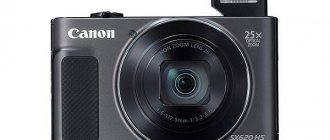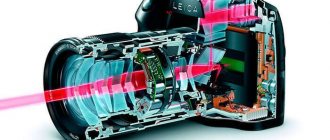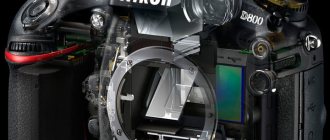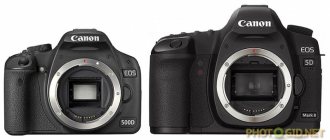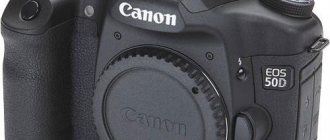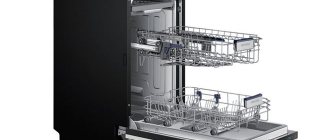What is a SLR camera?
A DSLR is a camera whose viewfinder is based on a mirror. In general, there are single-lens and double-lens SLR cameras. But since in the world of digital photography there is only room left for the first type, it will be discussed further.
The first single-lens reflex camera appeared in 1861. Yes, while serfdom had just been abolished in Russia, the camera had already been invented in England. That is, the history of the SLR camera began in the century before last, more than 150 years ago.
Of course, the first SLR cameras were very different from what we have now. One of the differences is the use of film. Today, film, as you all know very well, is practically extinct and exists only thanks to enthusiasts who fell in love with film photography once upon a time. Digital technologies have made it possible to replace the film in the camera with a matrix.
Let's return to the design of a SLR camera. Every DSLR has a mirror-based viewfinder. The mirror stands at an angle of 45 degrees and allows you to see a real non-digitized image through the viewfinder. The mechanism, in general, is quite simple from the point of view of understanding. Through the lens, light (and the image, respectively) enters the camera body, where a mirror is installed at an angle of 45 degrees. The light reflected by the mirror rushes upward, where it enters a pentaprism (or pentamirror), which wraps around the image, giving it its normal orientation. Simply put, if there were no pentaprism, the image in the viewfinder would appear upside down. That's all. This is the optical viewfinder - a distinctive feature of any DSLR.
DSLR vs Mirrorless: Previewing Images
In a DSLR, the optical viewfinder shows what the camera is capturing through the lens. With a mirrorless camera, you get a digital preview of the image on the screen. Some mirrorless cameras have an electronic viewfinder (EVF), a small, high-resolution screen in the eyepiece that mimics the optical viewfinder of a DSLR.
Sony a6100 mirrorless camera has an electronic viewfinder (EVF)
In good lighting, the preview on the screen or EVF of a mirrorless camera will look close to the final image. But in situations where the camera can't cope (like low light or fast-moving subjects), the preview will be dim, grainy and choppy. This is because a mirrorless camera must slow down the speed at which it captures images to capture more light, but still must show you a moving preview. A DSLR, on the other hand, reflects light directly into your eyes.
However, one of the benefits of electronic viewfinders on mirrorless cameras is that they can give you a preview of what the final image will look like before you actually take the photo. If you change the shutter speed or aperture, for example, what you see in the EVF will change accordingly. Meanwhile, since an DSLR's optical viewfinder reflects light without altering the image, you rely more on the camera's metering and your experience when it comes to predicting what your final results will look like.
So, if you shoot mostly in good light, both types will work well. However, if you often shoot in low light or other difficult conditions, you will find it easier to shoot with a DSLR camera.
Winner: Draw. In many situations, both types of cameras provide very effective image previews.
What is a mirrorless camera?
A mirrorless camera, just like a DSLR camera, has interchangeable lenses. But, as you understand from the name, it does not have a mirror viewfinder. Inexpensive cameras use a screen instead of a viewfinder, while more expensive cameras use an electronic viewfinder. In fact, unlike an optical viewfinder, such a viewfinder shows us a digitized image. We can say that this is a small screen. It has a certain resolution, which is indicated in the camera specification. Naturally, as with a monitor, the higher the resolution, the better.
DSLR vs Mirrorless: Lenses and Accessories
Choosing a DSLR camera gives you access to a variety of lenses from a range of manufacturers, from cheap and satisfactory to professional and extremely expensive. Mirrorless models are more limited, offering access to a small number of lenses from the camera manufacturer, although the selection is growing. Since they've been around longer, DSLRs tend to have a better selection of other accessories, such as flashes.
The difference is especially noticeable among traditional camera manufacturers. Canon offers hundreds of lenses for its DSLR cameras (as does Nikon). However, right now Canon only has eight M lenses for its line of mirrorless cameras; Nikon offers 16 lenses for its Z-series mirrorless models. Third-party lens makers like Sigma and Tamron have also been making lenses for Canon and Nikon DSLRs for years. However, keep in mind that some of these lens models are quite old and may not be suitable for modern DSLRs. For example, some may not support autofocus.
Selecting mirrorless lenses is better suited for technology-focused companies. Sony, for example, now has about 50 E-mount lenses for its mirrorless models. Panasonic and Olympus, which use a Micro Four Thirds sensor, produce about 40 lenses that can be used with cameras from any manufacturer. Third party lens manufacturers also make a good selection for Sony and Olympus/Panasonic mounts.
Additionally, you can usually purchase adapters to use DSLR lenses on mirrorless cameras from the same manufacturer (for example, for Canon or Sony). But this often comes at the cost of changing focal length and zoom characteristics, and sometimes disabling or slowing down features like autofocus.
Winner: DSLRs DSLRs still offer access to a wider range of lenses, but the gap between the two types is quickly closing as more mirrorless lenses become available.
Why is a DSLR camera better than a mirrorless camera?
Let's first talk about why a DSLR is better than a mirrorless one.
- An optical viewfinder is not only a feature of a DSLR camera, but also its advantage over a mirrorless one. There are several reasons for this. First, the optical viewfinder shows the image in real time, raw and undigitized. That is, as your eye would see it without a viewfinder. Secondly, when using an electronic viewfinder there is a slight delay in the image, which is not present with an optical viewfinder. Those. with the latter you always see the picture in real time.
- Phase detection autofocus is unique to DSLR cameras. The latest models of mirrorless cameras have learned to use phase sensors on the matrix, thereby giving birth to a hybrid focusing system, but today it still does not reach the focusing speed of a SLR camera.
- DSLRs have better ergonomics This is due, among other things, to the fact that the mirror itself with the pentaprism takes up quite a lot of space in the carcass. Because of this, in fact, these cameras are so large. But this minus turns into a plus when you need to control the camera: especially professional cameras have excellent access to all important functions using buttons, wheels and other controls located on the body. Particularly noteworthy is the additional monochrome display, which is found in large SLR cameras and is never found in mirrorless cameras. This display is very helpful in professional photography, and it is never superfluous for amateur photography.
- Huge optics park . Remember when we said that SLR cameras have been produced for a century and a half? Nikon began producing cameras in the 50s of the twentieth century. Today, Nikon's optics fleet is huge and continues to grow. Of course, mirrorless cameras are still far from achieving such richness.
- DSLR cameras are generally less expensive Specific example. There is a Nikon D5100 with a Nikon 35mm 1.8G DX lens. This is a very inexpensive kit, costing less than 20 thousand. To get similar quality with a mirrorless camera you need to spend a lot more money.
- A DSLR camera turns on much faster than a mirrorless camera. In a split second, while mirrorless cameras can turn on in 3 seconds.
- life of DSLR cameras is significantly longer than that of mirrorless cameras. And the batteries themselves are usually more capacious. Thus, amateur cameras like the Nikon D7100 can shoot one and a half thousand frames on a single charge. Professional equipment, like the Nikon D4, can take more than 3 thousand pictures with a single battery charge.
- DSLR cameras are more reliable . Some of them have dust and moisture protection. This is why you are unlikely to see a photographer with a Sony A7 in the savannah. But with Canon 1Dx there is nothing to do. There are more of them there than lions and bison...
So, the main thing: today, professional shooting with a mirrorless camera is almost impossible.
A DSLR camera is preferable for commercial photography. And the amateur must decide for himself whether the advantages of a DSLR are important to him, or whether what a mirrorless camera offers is enough. More on this below.
DSLR vs Mirrorless: Size and Weight
Digital SLR camera bodies are comparatively larger as they have to accommodate the mirror and optical viewfinder mechanism. For example, the Nikon D3500 body is smaller than its predecessor, but still quite bulky at 76mm deep, plus a lens on the front. With the included 18-55mm lens, the camera weighs about 225 grams.
Sony a6100 mirrorless camera
A mirrorless camera body is usually smaller than a DSLR and has a simpler design. The Sony a6100 has a body that is just 40mm thick and weighs 0.6kg with the included 16-50mm lens. It is small enough to fit in a coat pocket or small purse.
However, it's worth noting that some of the newer mirrorless cameras - especially those with full-frame sensors - are almost as big and heavy as some DSLRs, so the savings in size and weight are negligible.
Winner: Mirrorless camera. You can easily carry a mirrorless camera with you and fit more equipment, such as extra lenses, into your camera bag.
Why is a mirrorless camera better than a DSLR?
Yes, but are there any advantages to a mirrorless camera that a DSLR camera doesn’t have? Eat. And now we will talk about them.
Olympus technology is one of the most popular mirrorless cameras on the market
- Size . This is the most obvious. Mirrorless cameras are smaller. The optics for such cameras are also more compact. As a result, you can get a mirrorless system that will be smaller than a DSLR, but will allow you to get the same high-quality images.
- Electronic viewfinder . Electronic viewfinders also have their advantages. Firstly, they can display various additional information. Secondly, such viewfinders will be more convenient for nearsighted people. You need to use the optical viewfinder with glasses or use the diopter correction function, which is enough for vision of -2.5, but if the minus is greater, then alas. The electronic viewfinder, as we said above, is a screen. And, of course, when used by a nearsighted person, there are no problems with it.
- Large selection of manufacturers . Mirrorless cameras are now produced by the following companies: Nikon, Canon, Sony, Panasonic, Olympus, Fujifilm, Samsung. But affordable DSLRs are produced only by the first 3 companies plus Pentax.
What do DSLR and mirrorless cameras have in common?
There is one thing that these cameras have in common.
- Matrix . The most important part of a digital camera. Just a couple of years ago, I would have said that mirrorless cameras do not have a full-frame sensor. But Sony corrected this by releasing the A7 series cameras. They have matrices that are not inferior to those used in SLR cameras. We have already talked about matrices more than once; there is no need to repeat ourselves.
- Systematicity . For some reason, many people call mirrorless cameras system cameras, forgetting that DSLR cameras also belong to this class. This is the similarity between DSLRs and mirrorless cameras - these are system cameras that feature interchangeable optics.
What's better? DSLR or mirrorless?
There is no clear answer to this question. Everyone must make their choice based on their needs. My opinion is that DSLR cameras today are still too much superior to mirrorless cameras. For me personally, when choosing a camera, the most important criteria are speed (focusing, switching on), a wide selection of optics and price (both for the camera and lenses). Yes, you don’t always want to take a huge mirror set with you. It's better to have a choice. For example, for large (long, important, etc.) filming, have a DSLR, but for the soul - something small, maybe not even a mirrorless camera, but a compact camera like Fuji x100s or the like. But if you choose one single camera, then again, I would choose a DSLR. But that's just my opinion. What would you choose?
Related articles: Types of cameras How to choose a DSLR camera The best DSLR cameras 2014
